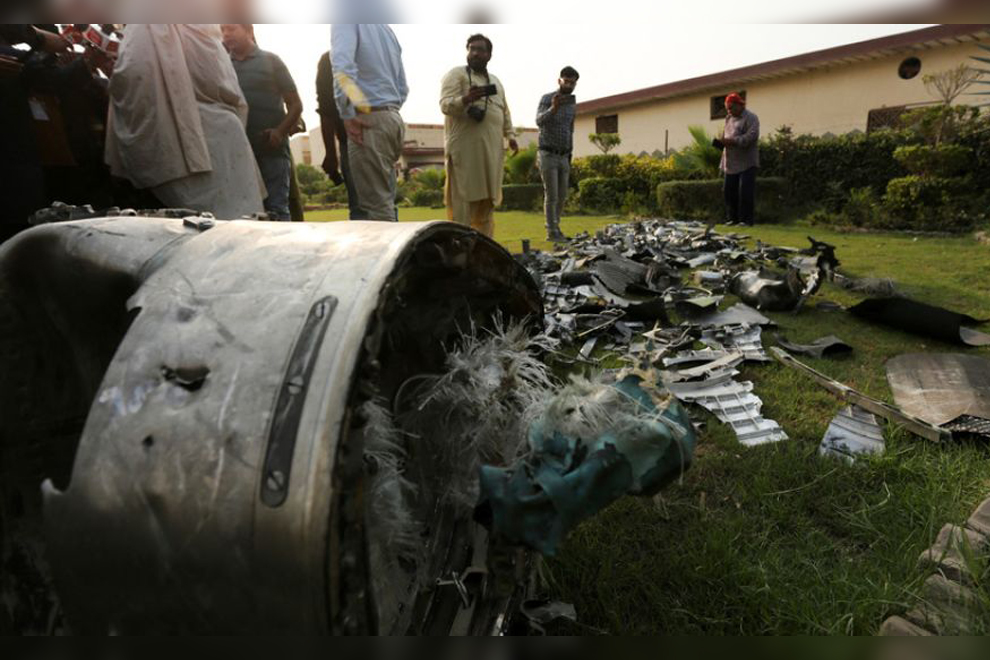
Journalists film missile fragments at the compound of an Islamic seminary after Indian strikes in Ahmedpur Sharqia, about 7 kilometers from Bahawalpur in Pakistan's Punjab province, on May 7, 2025. PHOTO: AFP
NEW DELHI – India and Pakistan are teetering on the edge of open conflict, after the Indian military struck deep within Pakistan in the early hours of May 7 in retaliation for a terrorist attack that killed 26 civilians in India-administered Kashmir in April.
In the most expansive action ever taken on its neighbour, India rained air strikes on what military officials said were “terror camps” in territory as far away as 30km from the de facto border.
Pakistan called this “an act of war”, saying that the 26 people who died included civilians and vowed to respond “at a time, place and manner” of its choosing.
Meanwhile, cross-border shelling along the Line of Control, the de facto border, on May 7 killed around 15 people in India, said media reports here.
With the nuclear-armed neighbours now engaged in a tit-for-tat spiral, officials and analysts on both sides are also in a race to shape the narrative for what comes next.
Those in India say that the ball is now in Pakistan’s court and that whether the clash escalates is up to Islamabad. Those in Pakistan say that New Delhi’s actions leave Pakistan with little choice but to strike back with full force.
“I do see a limited conflict looming because India has hit Pakistan in multiple places,” said Dr Qamar Cheema, executive director of Sanober Institute, an Islamabad-based think-tank.
“India has attacked Pakistan’s mainland. Pakistan would strike back with full force.”
Professor Harsh V. Pant, vice-president for studies and foreign policy at the New Delhi-based think-tank Observer Research Foundation, said that India does not want the situation to escalate further.
“Ultimately this is a question for Pakistan – whether they want to climb the escalation ladder,” he said.
India’s operation comes two weeks after gunmen killed 26 people – 25 Indians and one Nepali – in Pahalgam, a tourist hub in Kashmir. New Delhi pointed the finger at Islamabad, which it accuses of harbouring terrorists.
India’s Foreign Secretary, Mr Vikram Misri, said that its counter-actions in striking terror camps in Pakistan, including those of Pakistan-based terror groups Jaish-e-Mohammed and Lashkar-e-Taiba, “were measured, non-escalatory, proportionate and responsible”.
The Indian government has called its missile attack Operation Sindoor, referring to the red vermillion powder married Hindu women wear in their hair parting.
It brought symbolism to a mission meant to avenge the trauma of 25 women who watched as their husbands were shot by militants in Pahalgam.
At the press briefing on the operation on May 7, Mr Misri was flanked by two women officers, which was greeted with approval by the public. Many Indian celebrities and social media users called the sight of two women officers inspiring, with political analyst Saba Naqvi saying it was “good optics”.
But Pakistan, which denies being involved in the April 22 attack and has called for a neutral investigation, struck back at India’s assertion that no civilians were hurt in its May 7 strikes.
It said that 26 civilians, including a three-year-old girl, died, and released disturbing photos of civilians allegedly killed and injured. The estimates of civilian deaths across Pakistan’s media have ranged from 10 to 26.
Pakistan’s military spokesman Ahmed Sharif Chaudhry said that the girl was killed in a mosque in Punjab province. The image of a child in white clothes being treated by gloved doctors in a hospital has been shared widely.
Pakistan also said that it shot down five Indian jets on May 7. There was no response from India on the downing of the jets.
The clash has evoked nationalist fervour in both countries, with many closing ranks with their respective governments.
In India, where many had sought strong action against Pakistan, schools in many parts of the country were shut early as the Home Ministry asked states to conduct mock civil drills to test evacuation plans.
The mood was also grim in Pakistan, with many expressing anger and outrage for the death of civilians in the air strikes, as well as alarm over India’s threat to halt the water supply that flows from the Indus River into Pakistan.
The two countries fought two wars over Kashmir – claimed in its entirety by both – in 1947-1948 and 1965, and a limited conflict in 1999.
There have also been more recent cross-border strikes.
In 2016, Indian Army commandos crossed into Pakistani territory and struck terrorist launch pads in the wake of an attack that had killed 17 Indian soldiers in an army outpost near the Line of Control.
And in 2019, India launched air strikes against what it said was a terror training camp in Balakot in Pakistan in retaliation for a suicide bombing in which 40 Indian soldiers were killed in Kashmir.
On both occasions, the two sides stepped back from the brink of conflict.
Professor C. Raja Mohan, a visiting research professor at the NUS Institute of South Asian Studies, said any further escalation in current hostilities will also depend on international pressure.
Calls for restraint have come from different parts of the world. The United Nations Security Council urged India and Pakistan to avoid military conflict and ease tensions.
China also called on both countries to show restraint, on May 7. A Chinese spokesperson said both countries needed to prioritise peace and stability.
US President Donald Trump said the rising tensions were a “shame” and sought a quick resolution, as Secretary of State Marco Rubio spoke to the national security advisers in both countries.
“The Indian Foreign Secretary said if Pakistan escalates, India will respond even more vigorously. Now this is where what the rest of the world does comes in. Do they step in and stop Pakistan from retaliating or do they step in after Pakistan has retaliated?” asked Prof Raja Mohan.
“Trump has said that he hopes this will come to an end quickly. If it is a moderate response (from Pakistan), attempts will be made to stop it here.”
Asia News Network/The Straits Times











